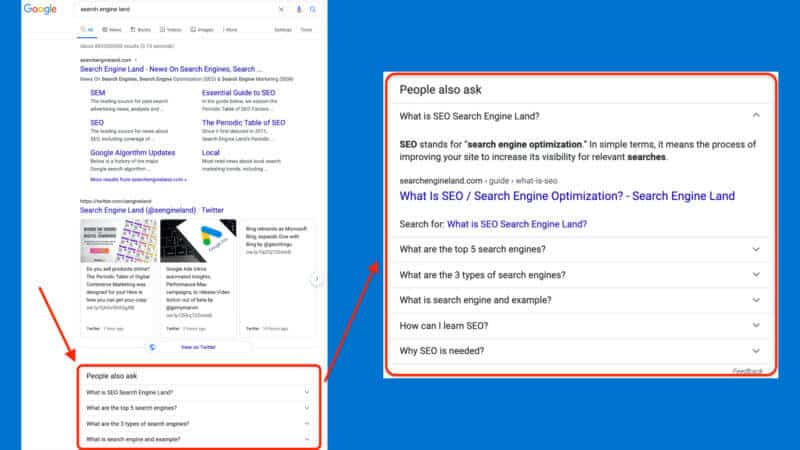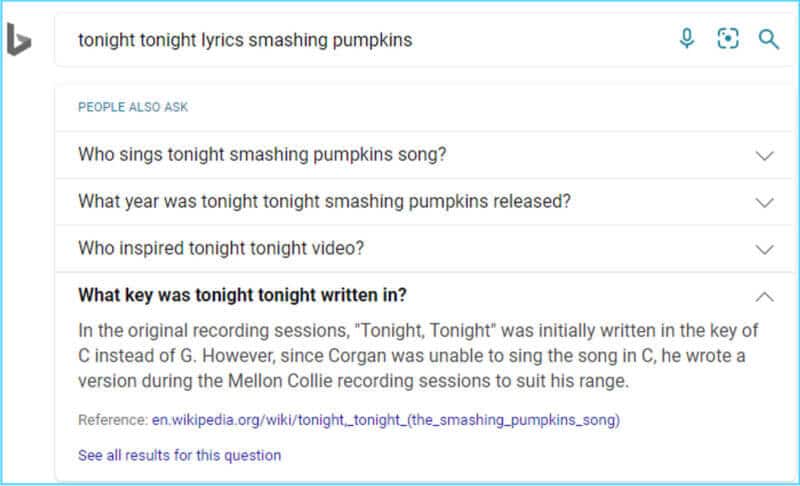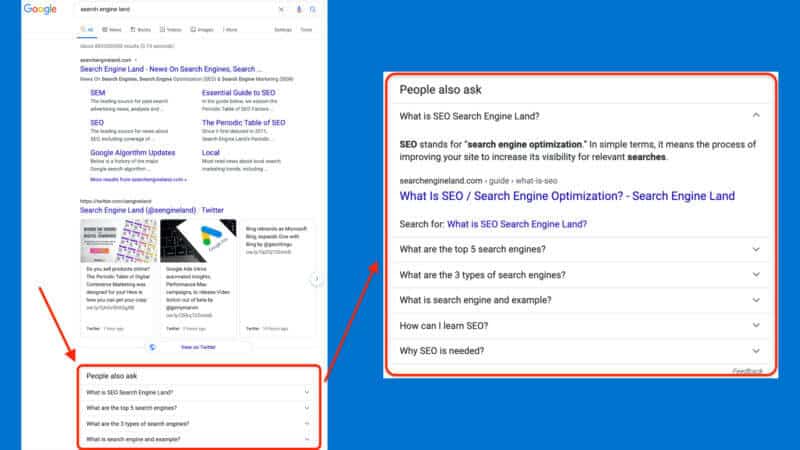Since it was first spotted in 2015, the People Also Ask (PAA) box has become a familiar feature on search results pages. So familiar, in fact, that it appears in both Google’s and Bing’s results, with the former search engine presenting it in 49% of all searches, according to a study of a one-million-keyword dataset by Olga Andrienko of SEMrush. That means the PAA box appears roughly four times more frequently in search results than featured snippets, which show in just over 12% of results, an Ahrefs study found.
Given their prevalence, People Also Ask boxes offer opportunities to improve your organic search performance, generate content ideas and more. Below, you’ll find what you need to know to make PAA boxes work for your marketing strategies and goals.
A brief overview of the PAA box
The PAA box generally includes three to four questions related to the topic of the user’s query. Google can surface the PAA box for different types of search intent. It appears within the top three results 75% of the time, according to SEMrush.

When a user clicks on a question in the PAA box, an answer is shown within the box along with a link to the webpage that hosts the answer. Answers are typically provided in the form of text, but Google has been spotted testing videos in the PAA box as well.
In addition to revealing an answer, clicking on a question will dynamically generate more questions related to the one that the user clicked. There seems to be no limit to the number of times a user can click on a question and generate more PAA questions.
How the PAA box has evolved
Since its introduction, the PAA box has been updated to provide users with more accurate answers as well as questions to answers they may not have even thought to ask yet. These advancements signal that the PAA box isn’t going anywhere any time soon.
Dynamic loading. In 2017, Google’s PAA box gained dynamic loading, enabling the number of questions shown to the user to grow beyond the initial three or four. As mentioned above, the additional questions are related to the one that the user first clicked on.
Dynamic loading PAA boxes lets users explore search results by clicking on more questions to find the information they’re looking for instead of clicking on traditional results and then browsing through the page.
As the list of PAA questions grows through user interaction, listings that appear below the PAA box are pushed further down the page.
Identifying question-answer pairs. Bing’s PAA box uses natural language generation models to identify question-answer pairs within documents. When those documents appear on the search results, the generated question-answer pairs, along with similar questions that have been previously asked by users, are used to power the PAA box.

This helps Bing generate questions and answers in the absence of historical user data.
How to put the PAA box to work for your brand
Brand awareness and traffic. When users click on PAA questions, they’re exposed to brands as providers of information and may click through on answers to find out more.
Given their typically high position in search results, the PAA box provides brands and SEOs with an opportunity for visibility in a crucial section of the results page. And, unlike featured snippets that were deduplicated earlier this year, it is possible for the same URL to appear as a traditional organic listing on the first page of Google search results as well as in the PAA box. It’s also possible for webpages that aren’t ranking on the first page of Google search results to be included in the PAA box, affording sites in highly competitive spaces with a shot at frontpage visibility.
Content and keyword research. The PAA box can provide insights into questions that users may have about your industry or your product or services. Looking at the corresponding answers can also tell you about what kind of content Google considers worthy of surfacing as well as who your competitors may be.
This information can then be used to inform your content strategy and/or improve existing content so that it might appear in a PAA box. Additionally, the search intents reflected in the PAA box can provide insight into what users may have been thinking when they typed in those particular search terms.
How to get answers into the PAA box
The criteria used to determine which content might be served as answers in a PAA box are part of search engine algorithms, meaning that we just don’t know exactly what it takes beyond the patterns that SEOs have identified. Fortunately, the patterns identified suggest that providing a positive user experience, which you should be prioritizing anyway, can help your content land in a PAA box.
In his article The explosion of PAA: Answering questions is the new way to dominate search, Ryan Johnson provided the following guidance:
- Write complete questions and answers. Make sure that each question is asked and answered fully.
- Use plain language.
- Avoid sales language.
- Add Q&A schema.
You should also strive to be as concise, yet accurate, as possible — SEMrush’s study found that there were just 41 words per paragraph answer, with the longest answer encountered being 132 words.
To further take advantage of the expanding nature of the PAA box, consider adding follow-up questions and answers on the same page.
While implementing schema on your pages does not guarantee that you’ll earn a PAA listing, adding Question, QAPage, FAQ and How-to structured data can help search engines discern what your pages are about, which may help them surface for relevant queries.
Where to see reporting on your PAA listings
Data on impressions and clicks coming in through your PAA listings are only available within Google Search Console (GSC) when the PAA box is expanded to display your answer. And, all links within a single search result page element have the same position, Glenn Gabe of G-Squared Interactive explained in his guide to demystifying clicks, impressions and position in GSC.
This means that if the PAA box appears in position two, your listing within the PAA box will be reported in GSC as position two, regardless of whether your answer appeared as one of the original three or four PAA listings or the twentieth listing that has been dynamically generated.
The post ‘People Also Ask’ boxes: Tips for ranking, optimizing and tracking appeared first on Search Engine Land.
Source: IAB

